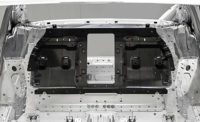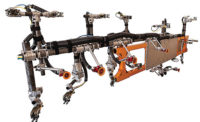Titans aren’t only located in Tennessee or gifted with god-like powers. Some operate in the real world and perform amazing manufacturing feats. A great example of this is a very large composites manufacturing robot used by NASA at its Marshall Space Flight Center in Huntsville, AL. Made by Electroimpact Inc., the robot helps NASA build lightweight composite parts for its Space Launch System (SLS), a heavy-lift rocket designed to take explorers on deep space missions starting in 2020.
“The robot builds [composite] structures larger than 26 feet in diameter, [which are] some of the largest ever constructed for space vehicles,” says Justin Jackson, the Marshall materials engineer who researched and installed the robot, and helped build and test one of the largest composite rocket fuel tanks ever made. “Composite manufacturing has advanced tremendously in the last few years, and NASA is using this industrial automated fiber placement tool in new ways to advance space exploration. Marshall’s investment in this robot will help mature composites manufacturing technology that may lead to more affordable space vehicles.”
NASA engineers already know that composites improve part quality, lower total production cost and allow for lighter rockets that can carry more payload—crew, science instruments, food, equipment and habitats—into space. In addition, NASA is researching whether composite parts can be used in exploration spacecraft such as landers, rovers and habitats.
The Electroimpact robot features
a 21-foot-long arm with an articulating head that holds up to 16 spools of carbon fibers. The head can be changed within 30 seconds for different projects, and the fibers are as thin as human hair. Company and NASA engineers worked together to customize the robot’s operating software.
To make composite parts, the robot articulates in multiple directions as it slowly moves along a 40-foot-long track. Fibers are released from all 16 spools, heated and adhered to tooling in precise patterns to form parts of varying shapes and sizes.
The tooling holds each part on a rotisserie-like system on a parallel track next to the robot. Finished parts are then tested in nearby structural test stands where spaceflight conditions are simulated. These tests determine if the parts are a good fit for space vehicles that will carry humans on exploration missions to Mars and other places.
The robot applies fibers at rates up to 2,000 inches per minute over ramped, complex surfaces. All fiber placement is performed in a fully bidirectional manner with operator control over the feed rate. To optimize assembly, the robot’s modular head allows multiple material forms on the same part (0.125 or 0.25 inch in high contour areas; 0.5 inch or wider in low contour areas), as well as offline material loading and cleaning.
Composite materials are used across NASA projects for everything from aircraft to human space vehicles to planetary probes, notes Larry Pelham, a senior engineer at the center. Because NASA is a partner in the interagency Advanced Manufacturing National Program Office, the agency will share all data from the SLS project with American companies to open up the marketplace for increased use of composites across a number of industries.
For more information on composites manufacturing robots, call 425-348-8090 or visit www.electroimpact.com.





